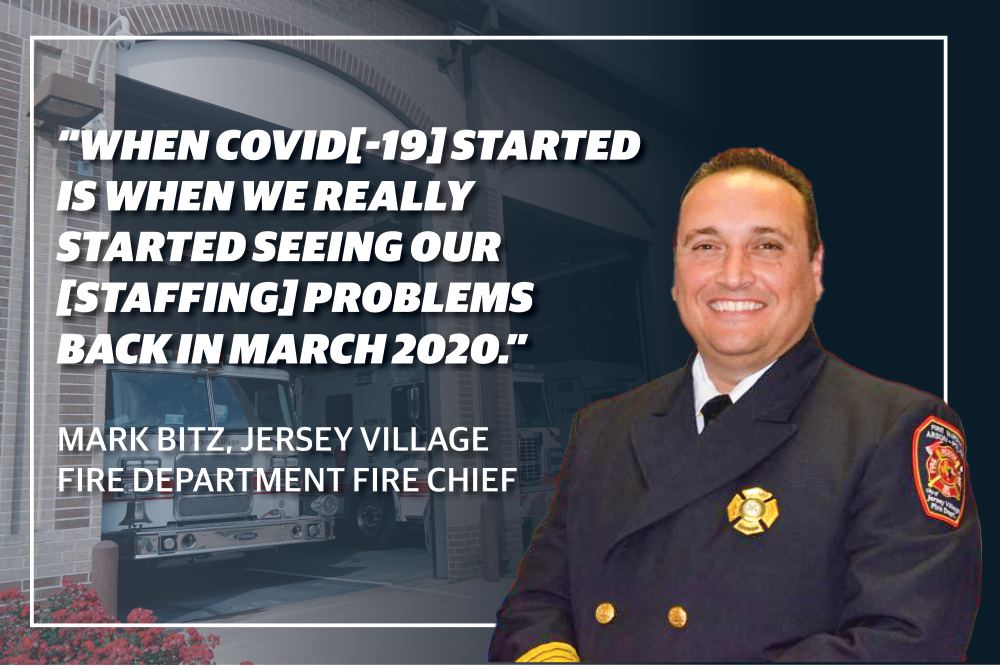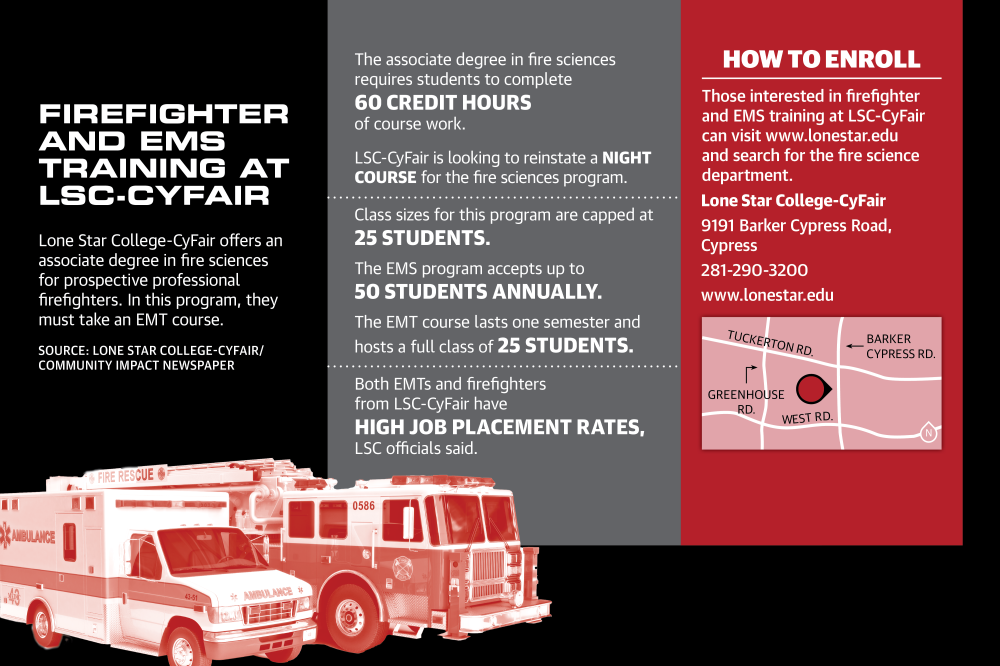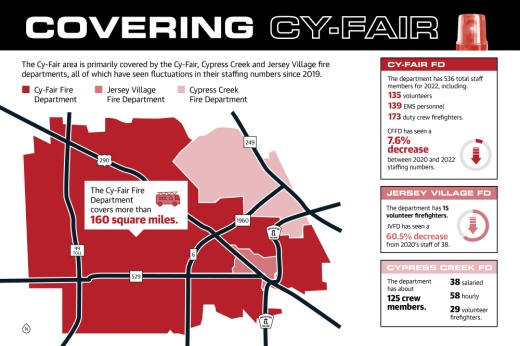Fire departments in the Cy-Fair area are adapting to staffing challenges as the number of volunteer firefighters has declined over the past three years while the annual number of responses by each department serving Cy-Fair have increased.
The challenge of recruiting and retaining volunteers has led some fire departments to transition to hiring full-time staff, including Cy-Fair and Cypress Creek fire departments in 2019 and 2016, respectively.
“As all of the fire departments in sort of the Harris County areas are transitioning from volunteer and combination departments into hiring full-time personnel and even part-time personnel, there’s a very big demand for certified firefighters and EMTs right now,” CCFD Fire Chief Richard Lieder said. “It’s quite a competitive hiring market.”
Cy-Fair Fire Chief Amy Ramon said while the department has had no problem filling full-time positions, the recruitment of volunteers has been an issue due to the time commitment.
“It’s a lot to ask of somebody to give seven to nine months of their life, taking an EMS class and learning how to be a firefighter,” she said. “It’s every weekend, and so there’s not a lot of people that want to just give up their life for that long to do something like that.”
However, smaller departments, such as the Jersey Village Fire Department, still rely solely on volunteers. JVFD Fire Chief Mark Bitz said the onset of the pandemic had aging volunteers and volunteers with young families warier about responding to calls and risking exposure to the virus.
“When COVID[-19] started is when we really started seeing our [staffing] problems back in March 2020,” Bitz said.
Low staffing, high response times
When the CFFD transitioned from a volunteer fire department in 2019, Ramon said the ability to enroll in the state’s pension system and offering competitive salaries and benefits allowed the department to attract more personnel.
“We wanted to be in the top percent so that we can give them a quality of life. If they’re happy, then in turn, they make the community happy,” she said. “A miserable employee is going to have poor customer service, and we can’t have that.”
While the CFFD has been able to expand its services in recent years, smaller departments receive assistance from other departments to adequately respond to emergencies.
Officials with the CCFD and JVFD said their departments can hold their minimum staffing levels but need more staff to comfortably respond to multiple emergency calls. As of May, the JVFD has 15 firefighters while the CCFD has 129 and the CFFD has 309.
“The problem that many departments our size see is when two calls come at the same time,” Bitz said. “So you might have a call that’s within a couple of minutes of another call, and when we’re out on one call, ... our staffing levels might not be appropriate to be able to handle that second call, which forces us to call another agency surrounding us for mutual aid.”
Mutual aid calls are common for the CCFD as well, due to its location and the dispatch center. According to Lieder, his team responds to calls in conjunction with departments from Klein, Ponderosa and Spring Northwest. Despite some staffing challenges, response times for the CCFD improved from 2020 to 2021 going from 6 minutes, 23 seconds to 6 minutes, 14 seconds. JVFD’s response time was down to 5 minutes, 53 seconds in 2021 but has jumped up to 6 minutes, 50 seconds in 2022.
Tommy Balez served as president of Emergency Services District No. 9—the taxing entity for the CFFD—for the past four years until he was unseated in the May 7 election. He said response times “used to be a problem, but I don’t think it’s a problem anymore.”
“I think our bigger issue in the longer term is just going to be the locations of our stations as well as the number of stations we have,” Balez said. “We’ve purchased a software that will take all of our dispatch information and then use artificial intelligence to tell us the ideal or optimal position [for our next fire station] based on our dispatching.”
The CFFD was unable to provide response time data by press time.
Volunteering gaps
The CFFD has hired new full-time firefighters and EMS staff since transitioning from reliance on volunteers. According to Balez, this was largely due to a steep drop in the number of people volunteering from 283 volunteers in 2019 to 135.
“So the mix has changed [since 2019], and we knew that when we did the transition,” Balez said.
The JVFD has 15 people helping to operate the fire department, compared to the department’s peak staffing of 41 volunteers in 2014. Bitz said the department is flooding job sites to boost its numbers, but he said his firefighters need to have a broader skillset.

“I think it’s more difficult for us because our staff has to do both [firefighting and EMS services],” Bitz said. “Many firefighters don’t want to get on an ambulance, and unfortunately for them, that’s what this business is about—80% of what we do is medical.”
Despite the idea that some firefighters do not want to do medical tasks, career firefighters are required to take courses on EMS skills and attain certifications to perform basic medical tasks. The step above this is paramedic skills, which, according to Bitz, is the highest level of care before the emergency room.
Addressing issues
From staffing to morale and mental health, local fire departments are facing numerous challenges when recruiting new or career firefighters. Some have different approaches than others, and the difference can lead to one department being fully staffed and another scraping by, officials said.
Even among departments that claim they are compensating and retaining their staff well, leaders are watching to ensure that all needs are met, physically and mentally, Lieder said.
“So mental health is starting to become a much more talked about topic in emergency services, fire, police and EMS,” Lieder said. “Just in 2020, [the] Cypress Creek Fire Department was awarded a grant from the governor’s office, and that allowed us to start up our whole internal mental wellness program, which is just one part of an overall wellness program that we have.”
Kyle Gunderson, a fire captain for the Houston Fire Department, said staffing shortages often force firefighters to take on extra shifts, which last 24 hours at minimum. On top of this, HFD has had trouble compensating its firefighters due to internal government conflicts. Gunderson said this has sent some to the CFFD, which provides better benefits and more consistent hours.
According to Ramon, the CFFD offers its firefighters and EMS personnel access to psychologists and psychiatrists through Baylor College of Medicine at no cost as well as telemedicine services through its health insurance plan. A more comprehensive mental health support plan is under development, which Ramon said includes partnerships with community counseling services.

To alleviate staffing burdens, departments are doubling down their efforts and recruiting from Lone Star College-CyFair. The next closest fire and EMS training programs are held at Texas A&M University in College Station, Wharton and LaPorte, LSC-CyFair EMS Instructor Kim Zapata said.
“So the demand with the growth of the Cypress area has pushed the need for more firefighters, more EMTs [and] more paramedics to service the community,” she said.
Demand is not just coming from the Cy-Fair area. Zapata’s husband Eric leads the Fire Academy at LSC-CyFair and said departments from across the state have come to recruit their graduates at career fairs.
“The students that come throughout these programs are really geared not only for getting into the workplace and serving our community right away but also have that longevity and career trajectory in their departments,” said Warner Bair, Division IV dean of the college of Public Services Health Behavioral Science.





